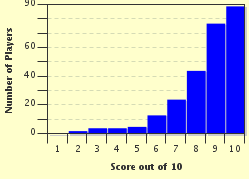Quiz Answer Key and Fun Facts
1. Though its author had been attempting to get the book published since 1905, this important collection of short stories was finally printed in 1914. Among the short pieces of fiction are often-anthologized pieces like "Araby" and "Counterparts", and one of the stories--"The Dead"--was made into a film by John Huston. All of the stories are set in the same city, which happens to be the capital of one of the countries shown in the photograph, and the title of the collection is simply the name for those citizens who reside in that city. What city is the setting for all of the stories in this book?
2. Many people with any sort of familiarity with the stories of Sherlock Holmes can tell you that the address of his abode is 221B Baker Street. While Baker Street really does exist, the numerical address did not at the time of the stories' original publishings. In what city would one find Baker Street, used by Arthur Conan Doyle as the setting of his stories? The accompanying photograph should help, if you don't already know.
3. In the early 1920s a young William Faulkner met the already-established American writer Sherwood Anderson in New Orleans. Anderson advised Faulkner to give up poetry, to focus on fiction, and to write about what you know. Faulkner did just that. Much of what he wrote, such as "The Sound and the Fury" and "As I Lay Dying", was set in a county he referred to as Yoknapatawpha. However, for what county and state did Faulkner use this coined American Indian name as a substitute?
4. If the characters from a famous 1925 American novel were alive in the twenty-first century, they would have seen such a skyline as the one shown in the photograph. After driving from East Egg or West Egg and through the "valley of ashes", they would approach a bridge connecting one island to another. At this point, they could admire the view in the picture. What city serves as a significant part of the setting for a story narrated by Nick Carraway?
5. Jake Barnes, Robert Cohn, and Mike Campbell all desire the "liberated New Woman" of the 1920s, Brett Ashley. When they all gather to experience the Festival of San Fermin, the young matador Romero becomes yet another competitor for Brett's affections. While part of this novel about the "lost generation" is set in Paris, France, a large portion of Ernest Hemingway's "The Sun Also Rises" is set elsewhere. What is this city where one might experience a scene like one in the photograph?
6. On board a boat anchored on the Thames near Gravesend, England, Charles Marlow relates a tale of "the horror!" he experiences on a trip down a river to retrieve the ailing Mr. Kurtz. As Marlow penetrates the "Heart of Darkness", he begins to realize that the irrational and brutal behavior of Europeans in their attempts at colonialization is no less savage than the behavior of the natives they condemn. European civilization is a fašade; we are all brutes. Along what river does Marlow travel through most of this novella written by Joseph Conrad?
7. Raskolnikov, an impoverished former student, murders a cold-hearted pawnbroker as well as her sister with an axe to prove his theories that those who have the will to commit murder have a right to do so and that, like Napoleon, taking lives to serve a greater purpose is justifiable. However, he then continuously deteriorates due to his anguish and guilt. The plot of Dostoevsky's "Crime and Punishment" is set in which Russian city, represented by its very famous Palace Square and Alexander Column in the photograph?
8. Kumalo, a black Anglican priest, travels from the country to a very big city to search for his son Absalom, only to discover that he has been arrested and is to be tried for the murder of the son of the rich white landowner from back home, James Jarvis. A powerful story of forgiveness and redemption follows, as well as a commentary on a social structure that has corrupted the lives of those who live within it. The title of this novel is "Cry, the Beloved Country", but to what beloved country is Alan Paton, the book's author, speaking?
9. In this 1989 best selling novel, four Chinese mothers create a club to play mahjong for money. Interestingly, the novel itself is put together like a game of mahjong in that each mother has one daughter and the novel is composed of a variety of chapters arranged in a pattern with each daughter and three of the four mothers narrating two chapters apiece. Overall, the reader experiences a meaningful commentary on the role of different cultures in women's lives, and on the challenges women face to find an identity in a sexist society. Using the photograph for a hint, can you choose the city where Amy Tan sets her novel?
10. Many are quite familiar with the fact that Tennessee Williams' "A Streetcar Named Desire" takes place in New Orleans. However, an earlier play of his about an aging mother and her two grown children living in a rundown urban apartment during the Great Depression takes place in another United States city. What is the setting of "The Glass Menagerie", the same place where Tennessee Williams himself lived for awhile and worked in a shoe factory, as does Tom Wingfield in the play?
Source: Author
alaspooryoric
This quiz was reviewed by FunTrivia editor
looney_tunes before going online.
Any errors found in FunTrivia content are routinely corrected through our feedback system.


